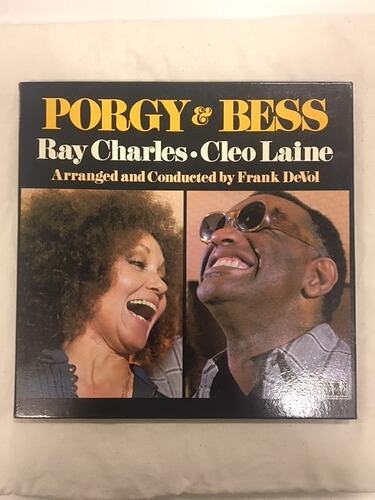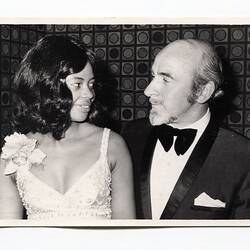Summary
Album of the stage production 'Porgy & Bess' performed by Ray Charles and Cleo Laine. It consists of an album box, containing a booklet of information within a plastic sleeve, two records in sleeves and a third, empty record sleeve. It was released in 1976. Lindsay and Sylvia Motherwell both enjoyed a variety of music, from jazz to musicals.
Sylvia Boyes (a South African-born orphan) and Lindsay Motherwell (a Melbourne-born drummer) met in Cape Town, South Africa in 1967 through their theatre connections. They fell in love but due to apartheid laws were forced to leave South Africa to marry in London. They subsequently relocated permanently to Melbourne in 1970.
Physical Description
An black album box with two large photos of Ray Charles and Cleo Laine on the front. Above these photos is the title "PORGY & BESS" in yellow text, "Ray Charles . Cleo Laine" in white text and "Arranged and Conducted by Frank DeVol" written in pale peach coloured text. The bottom of the box is black, with text down the right hand side with details of the record company and information about the record and copyright. Inside are several items; a booklet in a plastic sleeve, two 12" records in paper and plastic sleeves and a third sleeve which is empty and has no markings. The booklet has the same cover as the box, but in black and white. Inside the booklet is information about the history Porgy & Bess and this production. The two records have 5-8 songs on each side, and they are in record sleeves which have "MADE IN ENGLAND R.S. 7-76" and "U.K. Patent No. 1,072,844 Brevent SGDG 1,405,719 Eire 28160" on the front, and information and important notices on the back. The third sleeve is blank.
Significance
Statement of Historical Significance:
This collection provides a significant opportunity to represent political and personal freedom as a motivation for migrating to Australia within the international context of both apartheid in South Africa and the end of the White Australia policy in Australia. The personal narrative is well documented and the objects provide a material way to follow the lives of both Lindsay and Sylvia, both separately and where they coincide in South Africa and onwards together to Melbourne. While this is ultimately a love story, it plays out through the collection against the backdrop of apartheid South Africa, sixties London and an increasingly multicultural Australia.
More Information
-
Collecting Areas
-
User
-
User
-
Format
Gramophone Disc
-
Classification
Music & musical instruments, Playback media - analogue, Disc recordings
-
Category
-
Discipline
-
Type of item
-
Object Dimensions
316 mm (Width), 18 mm (Depth), 314 mm (Height)
Size of album cover
-
Keywords
South African Immigration, Travel, Musicians, Jazz Bands, Working Life, Apartheid, Racism, Immigration Policies, Music, Records

